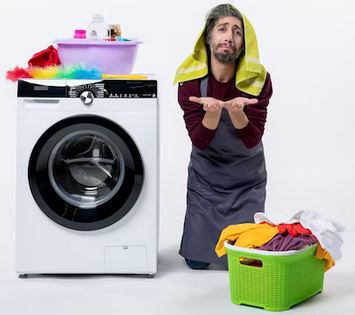Mold requires wet conditions and possibly poor airflow to sprout, and front load washers often offer them such conditions. The question, however, is, do all front load washers have mold problems?
All front load washers are susceptible to mold growth because their doors often trap moisture and lock out fresh air. However, that doesn’t mean that all front loaders are moldy. It usually depends on the cleaning and usage.
Speaking of usage, we must mention the detergent as too much or the wrong type could encourage too many suds, creating a humid condition that promotes mold growth. That’s, however, not everything.
I’ll also talk about prolonged laundry sitting, poor cleaning or the lack of it, excess fabric softener, poor airflow, and the door design. All these factors make front loaders susceptible to mold problems.
So, how about we get into it? Let’s start by looking at why front loaders are susceptible to mold.

Why Do Front Loaders Have Mold Problems?
Generally, front loaders have mold problems due to one primary reason – door design. Unlike top loaders, front loaders have a door design that locks airtight, trapping moisture in and locking out fresh air. That results in excessive dampness and poor airflow, which encourage mold growth.
Overall, it’s advisable not to shut the front loader door for too long when the washer isn’t in use. If you do, you’ll provide mold with the proper condition for sprouting.
It’s also worth noting that the front load door design features some folds/pockets that trap water, and sometimes mold hides there and proliferates. When cleaning, these pockets are often hard to reach–unlike top loaders.
Do All Front Load Washers Have Mold Problems?
While the door design of front load washers makes them susceptible to mold, it doesn’t mean all front loaders have mold problems. As I mentioned, it also depends on cleaning and usage, not just the door design.
Here are the factors that contribute to mold problems among front load washers:
- Poor cleaning or the lack of it – If you don’t properly clean your front loader, especially around the door seal and soap dispenser, the damp conditions will encourage mold growth. Similarly, mold will grow if you fail to clean the washer after use.
- Damp tub – It’s not enough to clean the washer, but you must also keep the tub dry. If some moisture remains in the tub and you happen to shut the door tight, the dampness will encourage mold growth.
- Excess detergent – Too much detergent means excess suds, creating damp conditions. Such conditions will attract mold.
- Wrong detergent – If you don’t use the correct detergent, especially if it’s not a high-efficiency (HE) option, excess suds may form, which creates humid conditions that encourage mold.
- Excess fabric softener – Too much fabric softener has the same effect as too much detergent. In both cases, you promote wet conditions, which attract mold growth.
- Prolonged laundry sitting – If you leave your wet laundry sitting in the tub for too long, it’ll create humid conditions in that mold thrive.
Are There Any Front-Load Washers That Don’t Get Moldy?
As much as front loaders are prone to mold, it doesn’t mean they are all moldy. Washer manufacturers are stepping up their efforts to make washers with mold-prevention technologies, and examples are GE Appliances and LG.
GE, for example, employs UltraFresh Vent System with Odor Block technology on some of its front loaders, especially Profile options, to prevent mold and other microbes. This technology works in three folds as follows:
- Drain – The technology encourages maximum washer drainage to avoid leaving any moisture behind, which could create damp conditions for mold growth)
- Dry – UltraFresh technology encourages fresh air entrance into the washer and its circulation, and that not only discourages mold growth but also gives the washer a fresh smell.
- Defend – Washers with UltraFresh Vent System are also infused with Microban technology, which stops microbial proliferation around the door seal, pump, and dispenser.
So, if you are looking for the best front-load washer to avoid mold, consider GE washers with UltraFresh Vent System with Odor Block. Alternatively, you can go for LG front loaders with Door-Stop technology.
Door-stop technology stops the washer from latching airtight, allowing trapped water some room to escape and for fresh air from outside to get in and circulate. Once that’s the case, mold cannot easily grow.

Do New Front Load Washers Still Have Mold Problems?
New front load washers can be susceptible to mold problems over time. That could happen if you use too much detergent or fabric softener or fail to clean the washer correctly. And, of course, you can expect the washer to smell like mold if you fail to leave the door open when the washer isn’t in use.
So, if you want your front load washer not to be moldy, clean and dry it after use and leave the door open to encourage fresh air flow. Don’t also forget to use the right amount of laundry detergent and fabric softener.
How Do I Keep My Front Load Washer from Molding?
Mold is preventable, and there are several things you can do to keep your front-load washer from it. They include the following:
1. Quick laundry transfer
Don’t leave the wet laundry sitting in the tub for too long. If you do, it’ll create wet conditions that attract mold. The danger of that is that not only will the mold attack the washer and spread, but it could also attack and damage your clothes.
And even if the mold doesn’t damage the clothes, they’ll likely smell like mildew, and you don’t want that.
2. Proper cleaning
It’s essential to clean your front load washer after use. Remove all soap residues and dirt, especially in the tub and around the gasket and soap dispenser.
Ideally, you should clean the washer after every use and do a deep cleaning at least once a month. I’ll explain more about ways you can clean your front loader later.
3. Proper drying
It’s not just important to properly clean the washer but also to leave it dry. Ensure there are no folds with trapped water, especially around the gasket, as that’ll attract mold growth. Preferably, use a dry piece of cloth to wipe the washer dry.
4. Proper aeration
Fresh air circulation is vital to keeping mold away. One way to ensure that’s the case is to leave the door open after using or washing the washer. That’ll encourage trapped moisture to escape and discourage any wet conditions that could cause the mold to spark.
Another way to ensure your front load washer has adequate aeration is to position it in an open space with unrestricted airflow. If you find it hard to leave the door open, perhaps for fear that your cat or any other pet may soil it, consider using a Door-Doc Front Load Washer Mold and Odor Prevention Rescue (View on Amazon). The feature holds the washer door in a perfect position to promote adequate aeration and prevent mold growth in the long run.
5. Correct detergent and fabric softener use
If you use the wrong detergent, it’ll encourage excess suds formation, and that’ll only create extra dampness. If that’s the case, the mold might grow. The same could also happen if you use too much fabric softener.
6. Warm water use
While this is not a major contributor to mold on washing machines, it could still matter. Mold proliferates more under cold conditions and, including cold water. So, it makes sense to use warm water if you are struggling with it, as such conditions don’t favor their growth.
7. Proper drainage
Lastly, if your front load washer doesn’t drain properly, the residual water will create damp conditions, which can attract mold growth. So, it’s essential that you check your front loader’s drainage to ensure that everything is okay. If drainage issues occur, check for blockages, clear them, and ensure the drain hose pipe is well-positioned to avoid backflows.

Ways to Clean a Moldy Front Load Washer
Overall, there are at least three ways to go about cleaning a moldy front load washer, and they are as follows:
1. Tub Clean Cycle
The tub clean cycle is an effective deep cleaning cycle that thoroughly cleans the washer tub and removes mold. In addition, it gives your washer a fresh, pleasant smell while improving its overall laundry cleaning efficiency.
Note that different washer brands have their version of the tub cycle as follows:
- Tub Clean Cycle on LG and Electrolux washers
- Drum Clean on Bosch washers
- Self-Clean on Samsung washers
You can check on your front loader manual to determine how to run the tub clean cycle.
2. Commercial Cleaner
One commercial cleaner you can use to wash your front loader is Affresh. It allows you to clean the tub, the door gasket, the soap dispenser, and every other part.
3. Home Cleaning Solution
You can also make a washer cleaner at home using home solutions and readily available reagents. That includes the following:
- ½ cup baking soda + 1 cup distilled vinegar solution
- 1 cup bleach solution + 1-gallon water
- 1-part white vinegar + 4-part lemon juice
How to Clean Moldy Front Load Washer
With the right washer cleaning solution or commercial cleaner, you can go ahead and clean your moldy front load washer as follows:
- Prepare the cleaning solution as shared above
- Empty the washing machine
- Start cleaning around the door seal/gasket using a soft cloth drenched in the cleaning solution.
- Clean the detergent dispenser with a soft cloth soaked in the cleaning solution. You can also use a small soft brush to scrub the detergent dispenser.
- Clean the tub and other interior part
- Run the deep-clean or hottest wash cycle to clean the tub properly
- Run the longest cycle to rinse off the washer and remove any residues
In conclusion, do all front load washers have mold problems?
As shared, all front loaders, regardless of brand or model, can be susceptible to mold problems, mainly because of their door design. Factors like poor cleaning and drying, excess detergent or fabric softener, and prolonged laundry sitting can worsen the situation as they encourage mold growth.
Mold is, however, preventable by keeping the washer clean, dry, and well-aerated. But more importantly, you can eliminate mold using commercial or home cleaners and the deep clean cycle, and you can refer to the above guide.
Also Read; Disadvantages of Front-Load Washers
